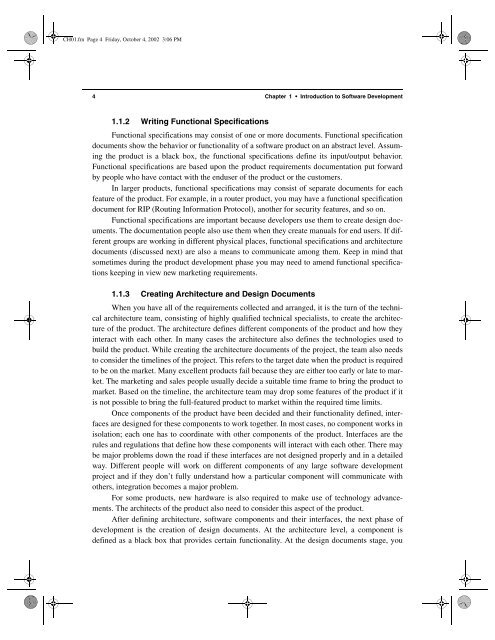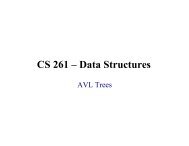The Linux Development Platform Configuring, Using, and ... - Classes
The Linux Development Platform Configuring, Using, and ... - Classes
The Linux Development Platform Configuring, Using, and ... - Classes
Create successful ePaper yourself
Turn your PDF publications into a flip-book with our unique Google optimized e-Paper software.
CH01.fm Page 4 Friday, October 4, 2002 3:06 PM<br />
4 Chapter 1 • Introduction to Software <strong>Development</strong><br />
1.1.2 Writing Functional Specifications<br />
Functional specifications may consist of one or more documents. Functional specification<br />
documents show the behavior or functionality of a software product on an abstract level. Assuming<br />
the product is a black box, the functional specifications define its input/output behavior.<br />
Functional specifications are based upon the product requirements documentation put forward<br />
by people who have contact with the enduser of the product or the customers.<br />
In larger products, functional specifications may consist of separate documents for each<br />
feature of the product. For example, in a router product, you may have a functional specification<br />
document for RIP (Routing Information Protocol), another for security features, <strong>and</strong> so on.<br />
Functional specifications are important because developers use them to create design documents.<br />
<strong>The</strong> documentation people also use them when they create manuals for end users. If different<br />
groups are working in different physical places, functional specifications <strong>and</strong> architecture<br />
documents (discussed next) are also a means to communicate among them. Keep in mind that<br />
sometimes during the product development phase you may need to amend functional specifications<br />
keeping in view new marketing requirements.<br />
1.1.3 Creating Architecture <strong>and</strong> Design Documents<br />
When you have all of the requirements collected <strong>and</strong> arranged, it is the turn of the technical<br />
architecture team, consisting of highly qualified technical specialists, to create the architecture<br />
of the product. <strong>The</strong> architecture defines different components of the product <strong>and</strong> how they<br />
interact with each other. In many cases the architecture also defines the technologies used to<br />
build the product. While creating the architecture documents of the project, the team also needs<br />
to consider the timelines of the project. This refers to the target date when the product is required<br />
to be on the market. Many excellent products fail because they are either too early or late to market.<br />
<strong>The</strong> marketing <strong>and</strong> sales people usually decide a suitable time frame to bring the product to<br />
market. Based on the timeline, the architecture team may drop some features of the product if it<br />
is not possible to bring the full-featured product to market within the required time limits.<br />
Once components of the product have been decided <strong>and</strong> their functionality defined, interfaces<br />
are designed for these components to work together. In most cases, no component works in<br />
isolation; each one has to coordinate with other components of the product. Interfaces are the<br />
rules <strong>and</strong> regulations that define how these components will interact with each other. <strong>The</strong>re may<br />
be major problems down the road if these interfaces are not designed properly <strong>and</strong> in a detailed<br />
way. Different people will work on different components of any large software development<br />
project <strong>and</strong> if they don’t fully underst<strong>and</strong> how a particular component will communicate with<br />
others, integration becomes a major problem.<br />
For some products, new hardware is also required to make use of technology advancements.<br />
<strong>The</strong> architects of the product also need to consider this aspect of the product.<br />
After defining architecture, software components <strong>and</strong> their interfaces, the next phase of<br />
development is the creation of design documents. At the architecture level, a component is<br />
defined as a black box that provides certain functionality. At the design documents stage, you

















